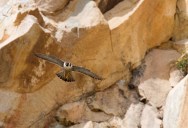The World’s Fastest Animals on Land, Sea and Air

Photograph by DECKSTER1965
CHEETAHS: THE WORLD’S FASTEST LAND ANIMALS
The cheetah (Acinonyx jubatus) is a large-sized feline inhabiting most of Africa and parts of the Middle East. They are the only felid with non-retractable claws and pads that, by their scope, disallow gripping (therefore cheetahs cannot climb vertical trees, although they are generally capable of reaching easily accessible branches). The cheetah, however, achieves by far the fastest land speed of any living animal—between 112 and 120 km/h (70 and 75 mph) in short bursts covering distances up to 500 m (1,600 ft), and has the ability to accelerate from 0 to over 100 km/h (62 mph) in three seconds.
Adaptations that enable the cheetah to run as fast as it does include large nostrils that allow for increased oxygen intake, and an enlarged heart and lungs that work together to circulate oxygen efficiently. During a typical chase, its respiratory rate increases from 60 to 150 breaths per minute. While running, in addition to having good traction due to its semi-retractable claws, the cheetah uses its tail as a rudder-like means of steering to allow it to make sharp turns, necessary to outflank prey animals that often make such turns to escape. [Source]

Photograph by GARY EYRING

Photograph by SAFARI PARTNERS

Photograph by SAFARI PARTNERS

Photograph by SAFARI PARTNERS
SAILFISH: THE WORLD’S FASTEST ANIMALS IN WATER

Photograph by ALEXANDER SAFONOV
Sailfish are two species of fish in the genus Istiophorus, living in warmer sections of all the oceans of the world. They are predominately blue to gray in color and have a characteristic erectile dorsal fin known as a sail, which often stretches the entire length of the back. Another notable characteristic is the elongated bill, resembling that of the swordfish and other marlins. They are therefore described as billfish in sport fishing circles.
Both species of sailfish grow quickly, reaching 1.2–1.5 metres (3 ft 10 in–4 ft 10 in) in length in a single year, and feed on the surface or at mid-depths on smaller pelagic forage fish and squid. Individuals have been clocked at speeds of up to 110 kilometres per hour (68 mph), which is the highest speed reliably reported in a fish. Generally, sailfish do not grow to more than 3 metres (9.8 ft) in length and rarely weigh over 90 kilograms (200 lb).
The sail is normally kept folded down and to the side when swimming, but it may be raised when the sailfish feels threatened or excited, making the fish appear much larger than it actually is. This tactic has also been observed during feeding, when a group of sailfish use their sails to “herd” a school of fish or squid.
Sailfish are highly prized game fish and are known for their incredible jumps. They can appear in a startling array of colors, from subdued browns and grays to vibrant purples and even silver. Their body colors are often highlighted by stripes of iridescent blue and silver dots. Sailfish can change their colors almost instantly; a change controlled by their nervous system. The sailfish can rapidly turn its body light blue with yellowish stripes when excited, confusing its prey and making capture easier, while signalling its intentions to fellow sailfish. [Source]

Photograph by ALEXANDER SAFONOV

Photograph by ALEXANDER SAFONOV

PEREGRINE FALCONS: FASTEST ANIMALS IN THE WORLD

Photograph by KEVIN COLE
The Peregrine Falcon (Falco peregrinus), is a widespread bird of prey in the family Falconidae. A large, crow-sized falcon, it has a blue-gray back, barred white underparts, and a black head and “moustache”. The Peregrine is renowned for its speed, reaching over 325 km/h (202 mph) during its characteristic hunting stoop, making it the fastest member of the animal kingdom.
The Peregrine’s breeding range includes land regions from the Arctic tundra to the tropics. It can be found nearly everywhere on Earth, except extreme polar regions, very high mountains, and most tropical rainforests; the only major ice-free landmass from which it is entirely absent is New Zealand. This makes it the world’s most widespread bird of prey. [Source]

Photograph by STEVE HAPP

Photograph by JOHN DALKIN

Photograph by NEIL O’REILLY

Photograph by PETE WALKDEN
If you enjoyed this post, the Sifter highly recommends:
Top 10 Facts of the World’s Largest Land Animal [20 pics]

Sign up to get our BEST stories of the week straight to your inbox.




